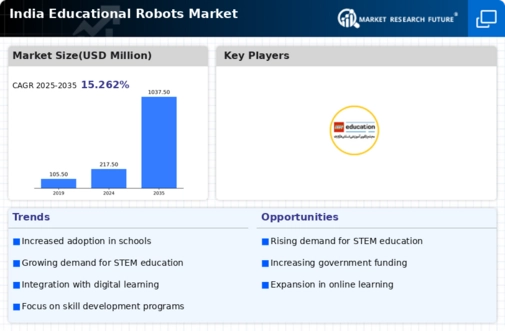Increased Demand for STEM Education
The growing emphasis on STEM (Science, Technology, Engineering, and Mathematics) education in India is a primary driver for the educational robots market. As educational institutions increasingly recognize the importance of equipping students with technical skills, the integration of robotics into the curriculum becomes essential. Reports indicate that the Indian government aims to enhance STEM education, potentially leading to a market growth rate of approximately 20% annually. This focus on STEM not only prepares students for future careers but also fosters innovation and creativity. Consequently, educational robots serve as effective tools for engaging students in hands-on learning experiences, thereby driving demand in the educational robots market.
Growing Interest in Robotics Careers
The increasing interest in careers related to robotics and automation is driving the educational robots market in India. As industries evolve and the demand for skilled professionals in robotics rises, educational institutions are responding by incorporating robotics into their curricula. This trend is reflected in the rising enrollment in engineering and technology courses, with a projected increase of 18% in the next few years. Educational robots play a crucial role in preparing students for these careers by providing practical experience and enhancing their understanding of complex concepts. Consequently, this growing interest is likely to sustain the momentum of the educational robots market.
Technological Advancements in Robotics
Technological advancements in robotics are transforming the educational robots market in India. Innovations such as artificial intelligence, machine learning, and advanced sensors are making educational robots more interactive and user-friendly. As these technologies become more accessible, educational institutions are more likely to adopt them for teaching purposes. The market is expected to witness a growth of around 25% as schools invest in modern educational tools that enhance learning experiences. These advancements not only improve the functionality of educational robots but also align with the evolving educational needs of students, making them a vital component of modern education.
Rise of Extracurricular Robotics Programs
Extracurricular robotics programs are gaining traction in India, significantly impacting the educational robots market. Schools and colleges are increasingly establishing robotics clubs and competitions, which encourage students to explore robotics beyond the classroom. This trend is supported by various organizations that provide resources and funding for such initiatives. The educational robots market is projected to benefit from this rise, with an estimated increase in participation rates by 30% over the next few years. These programs not only enhance students' technical skills but also promote teamwork and problem-solving abilities, making them attractive to educational institutions.
Government Initiatives for Skill Development
Government initiatives aimed at skill development are significantly influencing the educational robots market in India. Programs such as Skill India and Digital India are designed to promote technological education and enhance the skill sets of the youth. By providing funding and resources for educational institutions, the government encourages the adoption of robotics in classrooms. This support is likely to result in a market growth of approximately 15% as schools integrate educational robots into their teaching methodologies. Such initiatives not only prepare students for future job markets but also foster a culture of innovation and entrepreneurship.











Leave a Comment